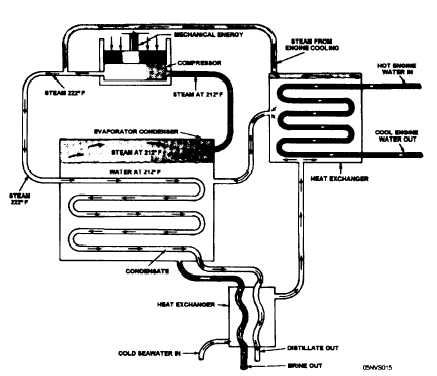Heat flows through the bottom of the evaporator, enters the water, and changes the water to steam. The steam is condensed in the condenser, its latent heat of vaporization being transferred to the water surrounding the tubes. A portion of the cooling water that has picked up heat in passing through the condenser is used as feedwater for the evaporator. All dissolved solids remain in the equipment and noncondensable gases are vented to the air so the resulting distillate is almost pure. Thus the distillation process is usefull in producing water of an extremely high purity and low in total solids,
Despite this high degree of purity, all distilled water must be disinfected before being consumed because of the possibility of recontamination during handling , I n thermocompression distillation, the latent heat of vaporization of steam is again used to produce additional steam. The pressure and temperature of the steam generated in the evaporator are raised by compressing the steam. The compressed steam passes to the condenser section where it condenses, giving up its latent heat and causing more steam to form in the evaporator. This steam is then compressed and the cycle repeated. The use of combination evaporator-condenser with a steam compressor creates a closed heat cycle, permitting the continued reuse of the latent heat of vaporization. The compressor is driven by a gasoline or diesel water-cooled engine.
Figure 9-13 shows the operation of a simple thermocompression distillation unit. Cold raw water flows through heat exchangers where it is heated almost to boiling by the outgoing streams of distillate and brine and by water from the engine that drives the compressor. The hot raw water flows into the evaporator-condenser and is

Figure 9-13. - Flow diagram-thermocompression distillation.
Continue Reading